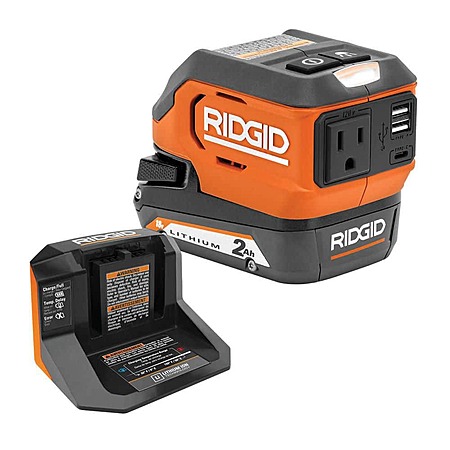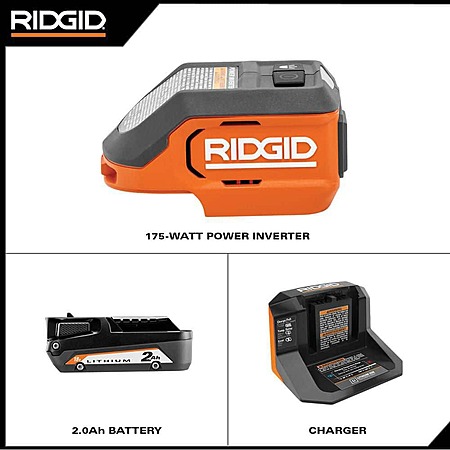popularidk_then | Staff posted Jul 30, 2024 01:44 AM
Item 1 of 2
Item 1 of 2
popularidk_then | Staff posted Jul 30, 2024 01:44 AM
Ridgid 18V Cordless 175-Watt Power Inverter + 2.0 Ah Battery & Charger $79 + Free Shipping
$79
$208
62% offHome Depot
Get Deal at Home DepotGood Deal
Bad Deal
Save
Share


Leave a Comment
17 Comments
Sign up for a Slickdeals account to remove this ad.
Our community has rated this post as helpful. If you agree, why not thank ChiefAlchemist
Our community has rated this post as helpful. If you agree, why not thank BN30
Our community has rated this post as helpful. If you agree, why not thank Dabears34
Sign up for a Slickdeals account to remove this ad.
100W = 120V * A
A = 100/120 = 0.833A
2Ah/0.833A = 2.4 hours
Ideal math, of course. Probably ~2 hours more realistically.
A = 100/120 = 0.833A
2Ah/0.833A = 2.4 hours
Ideal math, of course. Probably ~2 hours more realistically.
amp x volts=watts, so for watt hours: 2ah x 18v = 36wh (Battery is 18v, not 120)
https://battlebornbatte
"The equation is watt-hours = amp-hours x volts."
"In this instance, if you don't know the number of watts, you'll multiply the total number of amp-hours times the voltage"
This would run a 100w load maybe 22min in a perfect world, but more likely a fair bit shorter, like 15-17min because even the best inverters lose quite a bit I believe. I'm no expert, but I'd guess 15-20% loss.
I figure 100w load /36wh = 2.7
60min /2.7 = 22.2min
22.2min x .8 (assuming 20% loss) = 17.7 minutes run time for continuous 100w load
Math might be more correct to figure the 20% loss from the 36wh at the start instead of at the end for time. I'm tired and it's like midnight and my brain no workie lol
36wh x .8 = 28.8wh
100w load / 28.8wh = 3.47
60minutes / 3.47 = 17.29 minutes for 100w continuous load.
amp x volts=watts, so for watt hours: 2ah x 18v = 36wh (Battery is 18v, not 120)
https://battlebornbatte
"The equation is watt-hours = amp-hours x volts."
"In this instance, if you don't know the number of watts, you'll multiply the total number of amp-hours times the voltage"
This would run a 100w load maybe 22min in a perfect world, but more likely a fair bit shorter, like 15-17min because even the best inverters lose quite a bit I believe. I'm no expert, but I'd guess 15-20% loss.
I figure 100w load /36wh = 2.7
60min /2.7 = 22.2min
22.2min x .8 (assuming 20% loss) = 17.7 minutes run time for continuous 100w load
Math might be more correct to figure the 20% loss from the 36wh at the start instead of at the end for time. I'm tired and it's like midnight and my brain no workie lol
36wh x .8 = 28.8wh
100w load / 28.8wh = 3.47
60minutes / 3.47 = 17.29 minutes for 100w continuous load.
I agree about loss. The inversion process itself consumes power and is inefficient, that's why I took that 0.4 hours off my guess too.
Sign up for a Slickdeals account to remove this ad.
I agree about loss. The inversion process itself consumes power and is inefficient, that's why I took that 0.4 hours off my guess too.
So the amps would be fairly small. Would be like 1.45 amps max. That would also explain its 175 watt rating. 120v x 1.45amp = 174w
That 100w bulb then would be running off 120v @ like just over .8 amps. Just like it would in your home.
*modified sine wave vs pure sine wave being a big difference though.
Usually it's bad to trust small cheap inverters with the more sensitive electronics, but that is a whole other topic.
Some helpful ways of looking at these terms for those who are interested:
*Voltage is like the pressure of water in a pipe
*Amps (current) is like the flow rate of water from a pipe
* together voltage x current = watts
*watts = power
Inverters just change direct current (the power from the battery) to alternating current the socket end (where that sine wave becomes important as well). You can get the same wattage output through various combinations of voltage x current. For general basic stuff we plug in around the home, it needs to be 120 volts (most commonly we use standard 15amp sockets).
An example of when amps and volts gets a bit tricky is when dealing with things that produce DC power, like a solar panel. Multiple 200w rated panels could all have very different ways of going about getting to 200w. One might do 20v x 10amp, another might 10v x 20amp, etc.
Anyhow, hope that helps.
*Insomnia break over*
Leave a Comment